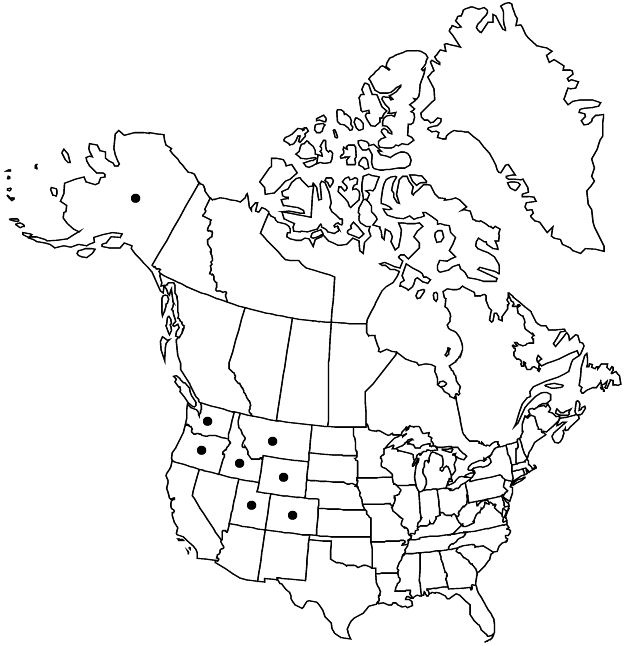Potentilla brunnescens
Bull. Torrey Bot. Club 28: 173. 1901.
Glands conspicuous, usually golden. Stems ascending to nearly erect, (1.5–) 3–7 dm. Basal leaves sometimes 2-ranked, palmate, (5–) 10–30 cm; petiole (1.5–) 5–25 (–50) cm, long hairs sparse to abundant, appressed to spreading, 1–2 mm, ± stiff, short, crisped, and cottony hairs absent, glands ± abundant; leaflets (5–) 7–9, at tip of leaf axis, separate to slightly overlapping, largest ones oblanceolate-elliptic to narrowly obovate, (2–) 5–10 × 1–4 cm, margins flat to ± revolute, distal 3/4 to nearly whole length ± evenly incised (1/4–) 1/2–3/4+ to midvein, undivided medial blade 2–15 (–20) mm wide, teeth (5–) 7–10 per side, linear to broadly lanceolate, 3–15 mm, surfaces ± similar, abaxial paler, green, not glaucous, long hairs sparse to common, short-crisped hairs absent or sparse, cottony hairs absent, glands ± abundant. Cauline leaves 1–3 (–4). Inflorescences 12–30 (–70) -flowered. Pedicels 0.2–1 (–4) cm. Flowers: epicalyx bractlets lanceolate to elliptic, 3–6 × 1–2 mm, hairs sparse to common, loosely appressed to spreading, glands common to abundant; hypanthium 4–6 (–8) mm diam.; sepals 4–8 (–9) mm, apex acute to acuminate; petals 6–9 × 6–10 mm; filaments 1–2 mm, anthers 0.6–1 mm; carpels 30–60, styles filiform-tapered, papillate-swollen proximally, 1.5–2 mm. Achenes 1.5 mm.
Phenology: Flowering summer.
Habitat: Vernally moist rocky flats, sagebrush benchlands and slopes, usually basaltic
Elevation: 400–3100 m
Distribution

Alaska, Colo., Idaho, Mont., Oreg., Utah, Wash., Wyo.
Discussion
The conspicuous golden glands, dark green color, and relatively broad leaflets make Potentilla brunnescens one of the better-defined species of sect. Graciles, though it has often been treated as a variety of P. gracilis. The glands, which are often on septate stalks, are particularly conspicuous on the epicalyx bractlets, hypanthium, and sepals, and at the junction of petiole and leaflets. The species occurs from the Blue Mountains of Oregon and Washington to western Montana, northern Utah, and north-central Colorado; collections from Alaska are probably not native.
As presented here, Potentilla brunnescens encompasses two morphological extremes that might merit varietal status. Leaflets of the more common and widespread extreme are incised about halfway to the midvein; in contrast, some populations in western Wyoming and adjacent Idaho have leaflets incised 3/4 or more to the midvein. The latter have often been assigned to P. gracilis var. elmeri while reserving P. gracilis var. brunnescens for the former; this is untenable because the type of P. brunnescens is the latter form.
Selected References
None.
Lower Taxa
"thin" is not a number."dm" is not declared as a valid unit of measurement for this property."(" is not declared as a valid unit of measurement for this property."dm" is not declared as a valid unit of measurement for this property."dm" is not declared as a valid unit of measurement for this property.